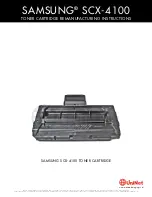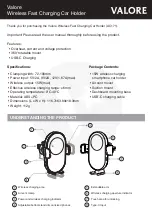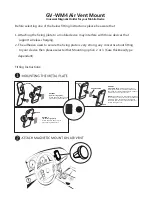
Established 1906
Fitting Instructions
Fitting Instructions
W T Knowles & Sons Limited
Ash Grove Pipe Works
Elland
West Yorkshire
HX5 9JA
www.wtknowles.co.uk
Code No: KNO300SQ
Bishop Gas Terminal
July 2018: Issue 2
©
WT Knowles & Sons Limited 2018
Instructions
•
Ensure the side drainage holes in the crown are clear.
•
Inspect the chimney stack for cracks and repair any defective mortar pointing. Check that
the flue liner is sound and totally clear of debris. Any mortar ingress into the flue liner should
be wiped clean to ensure a smooth passage for the flue gases and for sweeping.
•
A damp proof course should be installed below the top layer of brickwork. The space
between the outside of the flue liner and the chimney stack should be filled with insulating
backfill material such as weak lime mortar or lightweight vermiculite type insulating cement.
Ensure that the top of the chimney stack is flat.
•
When lifting large terminals onto a roof, the terminal should be fitted with suitable slings –
correctly positioned. The terminal should be carefully hoisted avoiding damage to the pot
and building, ensuring the safety of the installer and any nearby persons on the ground.
•
Position the terminal over the flue liner on the chimney stack and align vertically. The
terminal should be embedded into the top of the chimney stack by 125mm or one quarter of
the total height of the terminal, whichever is the greater, Ensure the terminal is securely
positioned. Remove the terminal.
•
Mix the mortar using a sand/cement ratio of 3:1. Apply a layer of mortar in the gap
between the chimney stack and the flue liner and embed the terminal over the flue liner and
press down onto the mortar. Ensure the terminal is vertical and securely placed.
•
Complete any outstanding brickwork (such as corbelling) around the base and then apply the
mortar flaunching. The mortar should fill the void between the terminal and the chimney
stack. The mortar flaunching should be smooth and tapered out at an angle between 25°
(minimum) and 45° to the edge of the brickwork to allow rain to drain away.
•
In warm dry weather the surface of the mortar flaunching should be dampened regularly to
prevent it drying out too quickly and cracking.
•
Ensure all gaps are filled with the mortar flaunching and brickwork to prevent the ingress of
water and to avoid losing mortar bonding.
•
Use a smoke test to check for leakage and to ensure the terminal is working correctly.
•
Close the fitted appliance and warm the chimney flue with a blow lamp or similar heating
device for approximately 10 minutes. Put smoke pellets in the appliance firebox (or bottom
of the chimney or appliance recess) and light. Close the appliance when smoke has formed
and allow the smoke to make its way up the chimney. Check for leakage throughout the
length of the chimney.
•
After the installation, the flue and chimney should be warmed through gradually to prevent
cracking and the drying out of the mortar between the flue and the terminal. This must be
done before initial use (on first firing) or after prolonged periods without use.
•
It is recommended that chimneys using gas fuel are regularly cleaned and inspected
annually.
•
For safety reasons, it is essential that any chimney pot or chimney cowl is correctly selected
and is suitable for the heating appliance being used.




















